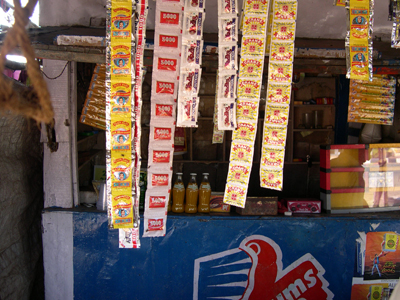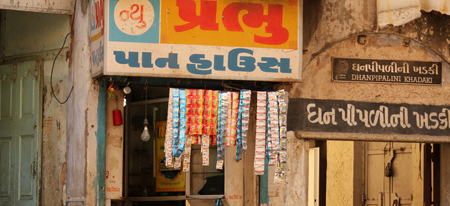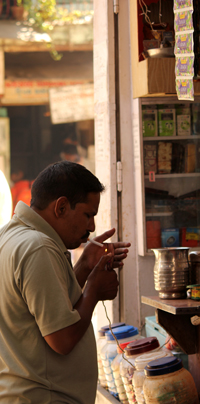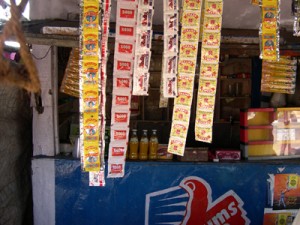by Kiran Keswani
[box]Streets in India bustle with life and are full of rich experiences. In a guest column for Spark, Kiran Keswani offers a glimpse of life on the streets as she has seen it, gently touching upon the diverse interesting aspects, particularly the myriad paan shops. Text and photographs by Kiran Keswani.[/box]Street life in India offers you what any good story does – a beginning, a middle and an end. Life on the street is as exciting as a dramatic story or an exciting film. The beginning may be the visual chaos and the maddening cacophony, the middle is the mass of people you jostle against as you manoeuvre your way through and the end is the collection of experiences you leave with.
You may encounter people, goods and autorickshaws. Along some part of the street, there are places where people pause, at the paan shop or at the Chai shop. These are the full-stops in the street before the next sentence begins. You may not be the paan-chewing type or the cigarette smoking kind and may never need to stop here. But then, we are often reading the story while someone else is writing it. So, one just reads on.
As you near the paan shop, your steps slow down or at least your eyes do, as they flow over the scene in front of you, of someone reading a newspaper (right there in the middle of the road!!), schoolboys buying a packet of chips, a man lighting his cigarette, an elderly man sipping his cup of chai. If you pause long enough and look long enough, you see this full-stop enlarge and become a page of happenings, a page of sharp detail. I think street life anywhere in India is like that.
Each of us chooses to see detail in a different way. I walked through Manek Chowk in Ahmedabad and found that every paan shop differed in its form, the space it occupied, how it positioned itself on the street and the context in which it functioned. The front views and the side views differed too. Often, in the paan shop, you cannot get a side view because it is a ‘hole in the wall’ shop and you find it embedded into a part of building that found its place here before the paan shop did.
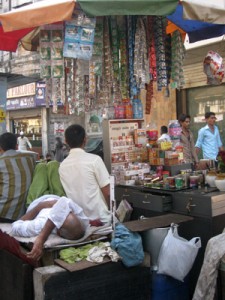
Just as there is always a place for the paan after a heavy meal, it seems as if there is always a place for a paan shop in a dense street.
This paan shop in Manek Chowk came into existence as a small stall on the roadside, selling paan or betel nut leaf and grew into the multi-tasking shop that today sells paan and much more. You can buy anything here, from cough lozenges to postage stamps. It is also the place where men “hang out” for a quick smoke or a cup of chai as they read their day’s newspaper or share the neighbourhood gossip.
In his book ‘Ways of Seeing,’ John Berger says, “Soon after we can see, we are aware that we can also be seen.” If we can see the paanwallah, we know that he can also see us. And how he defines us in this urban landscape, where we are both situated. In his eyes, we could be mere “passers-by.” Some of us are patrons of paan, some are not. Some are in a miserable hurry and others have all the time in the world. And how much time is folded into the length of a street? Perhaps only as much as each of us would give to ourselves and to the street. And when you reach the end, you could still be at the beginning as streets connect from one to the other, making walking in the city that unbounded experience where we see others and others see us and where life unfolds itself as and when you find the time for it.
Kiran Keswani is an architect based in Bangalore with an interest in Urban Planning issues. She was a Netherlands Fellow at the Institute for Housing and Urban Development Studies (IHS) at Rotterdam in 1996. She is currently researching the ‘Informal plan of the City’ and blogs at http://indianbazaars.blogspot.com.
[box type=”download”] If you have trouble opening the PDF, please right click on the button and select ‘Save Link As/Save Target As’. This will help save the PDF to your computer. If you still have trouble, drop us a mail at editors@sparkthemagazine.com and we will mail you the PDF straight to your inbox! DON’T MISS THE PDF EXPERIENCE![/box] [button link=”http://www.sparkthemagazine.com/wp-content/uploads/2012/04/spark-april-2012.pdf” color=”pink” newwindow=”yes”] Download the April 2012 Issue as a PDF![/button] [button link=”http://issuu.com/sparkeditor/docs/spark-april-2012?mode=embed&layout=http%3A%2F%2Fskin.issuu.com%2Fv%2Fcolor%2Flayout.xml&backgroundColor=000000&showFlipBtn=true” color=”purple” newwindow=”yes”] Click here to flip and read the issue like a magazine[/button]
[facebook]Share[/facebook] [retweet]Tweet[/retweet]

